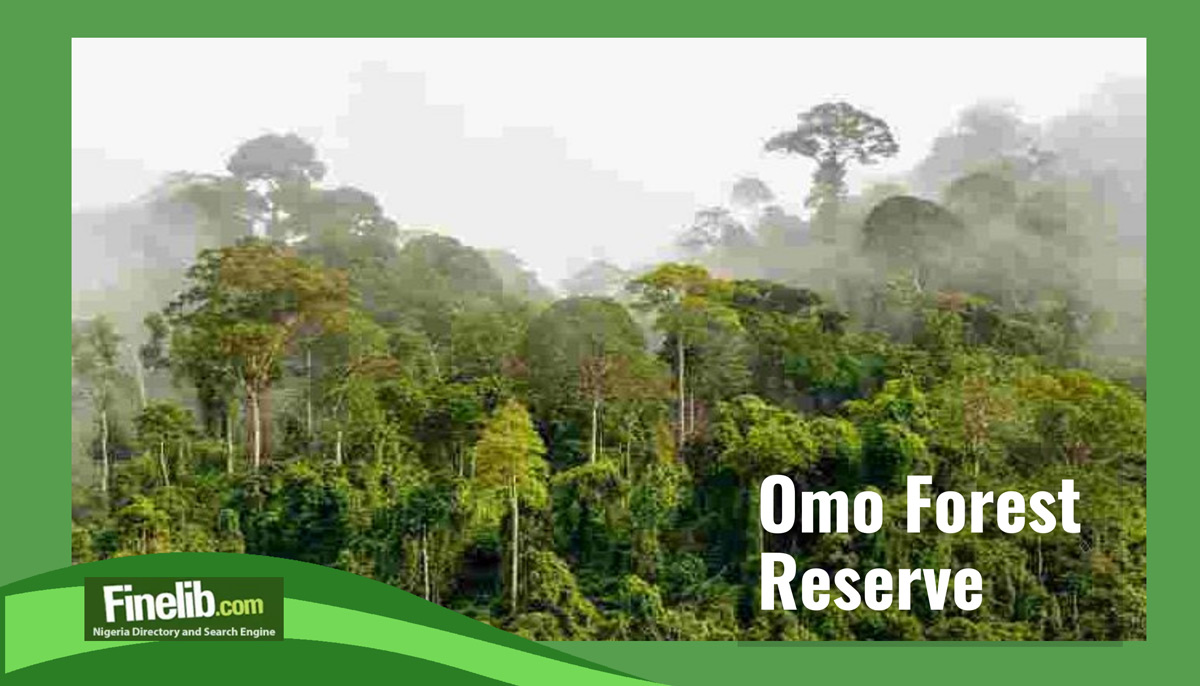Attractions, and History of The Omo Forest Reserve

If you are on the lookout for a place in Nigeria where nature thrives in all its glory and history whispers through the leaves, Omo Forest Reserve in Ogun State is a spot you cannot miss. Spanning a whopping 1305 square kilometres of tropical rainforest, this reserve sits about 135 kilometres northeast of Lagos, offering a proper escape into Nigeria’s wild heart.
Established in 1925 during colonial times, it is famed for its towering trees, rare wildlife, and a slice of untouched forest that has earned it UNESCO Biosphere status. Whether you are a Lagosian craving a weekend getaway or a visitor eager to explore Nigeria’s green wonders, this guide dives into its rich history, stunning attractions, and why it is a treasure worth discovering. Let’s take a stroll through this forest and uncover what makes it so special.
A Journey Through Time
Omo Forest Reserve has roots deep in Nigeria’s past, kicking off with its legal creation under British colonial rule via Order No. 10 of 1925. Back then, the forest was handed over by the Awujale of Ijebu Ode to the colonial government on 8 October 1918, first pegged as a timber goldmine for commercial logging.
Named after the Omo tree, a local giant that dots the landscape, it started as a resource hub, with sawmills like Omo Sawmills of Nigeria Limited cutting deals in 1950 to harvest wood. By 1952, the focus shifted from just chopping trees to protecting what was left, thanks to the Federal Department of Forestry setting up experimental plots to monitor the rainforest’s health.
Fast forward to 1977, and Nigeria scored a win when UNESCO tagged Omo as a Biosphere Reserve, spotlighting its pristine core—a 460 hectare Strict Nature Reserve within Area J4. This shift came as folks realised the forest’s real value lay in its biodiversity, not just its timber.
Over the years, it has faced logging, poaching, and farming pressures, but efforts from groups like Paignton Zoo (since 1993) and Pro Natura International Nigeria have kept it alive. From a colonial logging ground to a global conservation star, Omo’s story is one of resilience, a proper Nigerian tale of nature fighting back against the odds.
Where It Lies
Omo Forest Reserve stretches across Ijebu East Local Government Area in Ogun State, about 135 kilometres from Lagos and 80 kilometres east of Ijebu Ode. It hugs the Omo River on its eastern edge, a lifeline that drains the forest with its web of streams and tributaries, flowing into the larger Owena River system.
The terrain is mostly flat with some gentle rolling hills, peaking at around 300 metres on rocky outcrops like Beetle Hill. It sits close to other reserves like Oluwa to the east, though those neighbours are far more worn out.
Getting there is no big wahala. Jump on a bus from Lagos’s Berger or Ojota parks to Ijebu Ode for about 2000 naira, then grab a keke or taxi to J4 camp for another 1000 naira. If you are driving, the Lagos Ijebu Ode Expressway takes you close, with a turnoff near Area J3 or J4 settlements. It is Nigeria’s green escape, just a stone’s throw from the urban grind.
What Makes Omo Forest Reserve Shine
Omo is not just a forest. It is a living, breathing showcase of Nigeria’s wild side, packed with sights and activities to keep you hooked. Here is the full gist of what you can dive into:
- Nature Trails
Fancy a stroll? The reserve has trails winding through its thick canopy, from short walks near Erin Camp to longer treks past towering trees. You will brush past over 200 tree species—like Khaya ivorensis and Cordia millenii—some standing tall since before your grandparents were born. It is a proper chance to soak in Nigeria’s forest vibes, with every step revealing something new.
- Elephant Camp
Erin Camp is the heart of Omo’s elephant magic. Here, you might spot African forest elephants, rare giants that roam these woods. The camp offers basic cabins or tents for overnight stays, letting you wake up to elephant trumpets or the rustle of leaves. It is a raw Nigerian experience, no fancy frills, just nature doing its thing.
- Beetle Hill Climb
For a view that hits different, trek up Beetle Hill. It is a 45 minute drive from J4 camp to the base, or a two and a half hour walk if you are up for it, then a steep 25 minute climb to the top. The reward? A sweeping panorama of the forest stretching out below, with hills and rivers painting the scene. Pack a picnic—most trips include lunch—and enjoy the breeze up high.
- Birdwatching Bonanza
With over 125 bird species, Omo is a bird lover’s paradise. Spot the yellow casqued hornbill, long crested eagle, or white throated guenon flitting through the trees. Bring binoculars and a quiet step, and you will catch Nigeria’s feathered stars in action, especially near the riverbanks.
- Wildlife Wonders
Beyond elephants, Omo teems with life—chimpanzees swinging in the canopy, pangolins snuffling through the undergrowth, and civet cats prowling at night. The forest’s mix of primary and secondary growth shelters these rare critters, making every rustle a chance to spot something special. It is Nigeria’s wild side, untamed and free.
- Omo River Views
The Omo River cuts through the east, a lifeline for the forest’s ecosystem. Wander to its banks for a cool dip or just to watch the water flow, framed by thick greenery. It is a serene spot to chill, with the river’s gurgle adding a peaceful soundtrack to your day.
- Cultural Connection
The forest is not just nature—it is history too. Local communities like those in J4 have rights to hunt, fish, and gather snails or fruits, a bond tied to agreements from 1918. You might catch a glimpse of their life—rubber tapping or firewood collecting—a living link to Nigeria’s forest past.
Why Nigerians Flock Here
Omo Forest Reserve pulls people in for all the right reasons. It is a rare slice of Nigeria’s original rainforest, a green haven where elephants still roam and birds rule the skies. Lagos folks love it as a weekend escape, piling into buses for a taste of peace away from danfo horns and market noise.
Families bring kids to gawk at wildlife, while adventurers tackle Beetle Hill for the thrill. During holidays like Easter or Christmas, it buzzes with picnickers and campers, while conservation buffs roll in to see Nigeria’s biodiversity up close. For the Ijebu people, it is a pride point, a forest that has stood since their grandparents’ days, holding stories of survival and spirit.
How to Get There and Around
From Lagos, it is a two hour ride to Ijebu Ode—buses from Berger cost 2000 to 2500 naira, depending on your haggling skills. From there, a taxi or keke to J4 camp or J3 gate runs 1000 to 1500 naira. Drivers can take the Lagos Ijebu Ode Expressway, turning off near Ago Iwoye or J4, with parking at the camp’s edge.
The reserve is open daily, though hours flex with the seasons. Call ahead to Erin Camp at roughly 8 a.m. to 5 p.m. Entry is cheap, about 500 naira per head, with extras like camping or guided walks at 1000 to 2000 naira. Wear sturdy shoes, pack water, and bring cash; no POS machines are deep in the bush. Dry season, November to March, is best, with cool vibes around 25 degrees Celsius, though rainy months turn it lush and green, just watch for mud.
Why It Matters to Nigeria
Omo Forest Reserve is more than a getaway—it is a lifeline for Nigeria’s wild heritage. It shelters endangered species like forest elephants and chimpanzees, a living ark in a country that has lost 95 percent of its rainforests in the last century. For Ogun State, it pulls in naira from visitors splashing cash on transport, food, and guides, giving local communities a boost.
UNESCO’s Biosphere tag in 1977 put Nigeria on the conservation map, showing the world that we have treasures worth protecting. Beyond economics, it teaches school kids about ecosystems here while elders share tales of its past. It is Nigeria’s green pride, a forest fighting to stay alive amidst modern pressures.
Challenges and Dreams
It is not all rosy, though. Logging, poaching, and illegal farming keep chipping away at Omo’s edges—villages like Baoku have seen human elephant clashes, like the tragic 2018 stomping. Funding lags, leaving trails rough and cabins basic, while litter piles up when crowds roll through.
The government and NGOs like Paignton Zoo push back with rangers and school programmes, but more juice is needed. Dreams float around—better paths, a visitor centre, or eco lodges could turn it into a top draw. If Nigeria doubles down, Omo could shine as a global eco star, not just a local gem.
Tips for Your Visit
Hit Omo early—the forest wakes up with a cool breeze, and you will dodge the midday heat. Wear long sleeves and trainers, mosquitoes and roots do not play nice. Pack suya or chin chin, though J4 vendors might hook you up with fresh fish or fruits. Snap pics from Beetle Hill, but hold tight on the climb it is steep.
Camping? Bring a torch and mosquito net, nights get dark and buggy. Respect the locals—hunting and gathering are their rights, so no loud wahala. A guide costs 1000 naira and spills the best forest gist, from elephant tracks to bird calls. It is a family friendly spot too—kids love the wildlife, and the open spaces are picnic gold.
The Bigger Picture
Omo Forest Reserve is Nigeria’s green heartbeat, a rainforest that has seen colonial saws, local struggles, and modern dreams. It ties us to our Ijebu roots, our wild past, and our push to save what is left. In 2025, as Nigeria grows, this reserve keeps us anchored, a natural wonder blending biodiversity with history.
It is not just Ogun State’s pride but a nod to Nigeria’s depth, showing the world we have forests worth shouting about. From its elephant trails to its UNESCO core, it is a living story of resilience and beauty, a call to protect what makes Nigeria unique.
Final Thoughts
Omo Forest Reserve is not just a place to swing by it is an experience that hits you deep. Whether you are trekking to Beetle Hill, camping with elephants, or just soaking in the river’s calm, it offers a taste of Nigeria’s wild soul you cannot find elsewhere.
From its colonial timber days to its conservation glow, it is a forest with a tale to tell. So next time you are near Lagos or Ijebu Ode, do not dull, round up your crew, pack some naira, and head to Omo. It is a piece of our heritage, a slice of our nature, and a proper Nigerian treasure waiting to blow your mind. Step in, and let this forest show you what Nigeria is all about!




